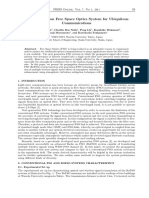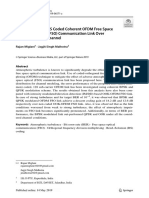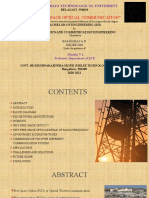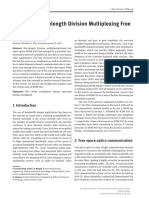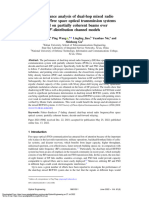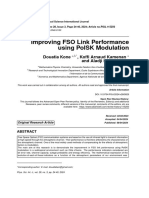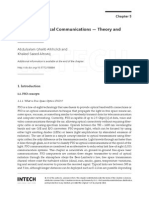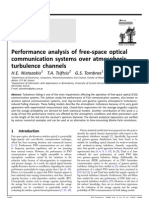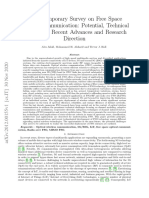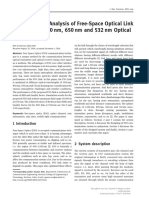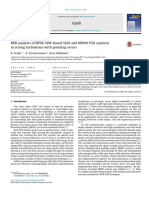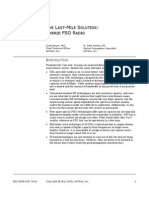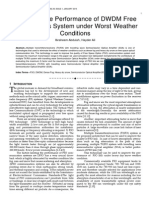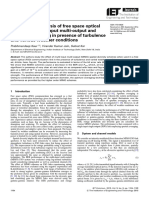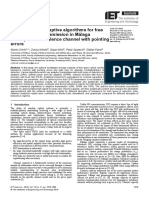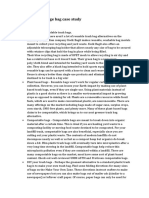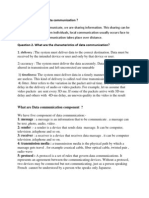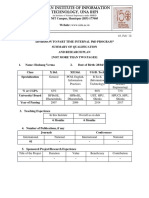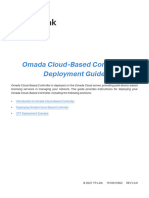Journal of Optics
https://doi.org/10.1007/s12596-024-01904-z
RESEARCH ARTICLE
Performance investigation of Ro-FSO link under clear and fog
conditions employing machine learning
Sanmukh Kaur1 · Anurupa Lubana2
Received: 9 March 2024 / Accepted: 10 May 2024
© The Author(s), under exclusive licence to The Optical Society of India 2024
Abstract
This work focuses on evaluating the performance of a radio over free space optical (Ro-FSO) communication system using
quadrature amplitude modulation-based orthogonal frequency division multiplexing (QAM-OFDM). Quality of transmis-
sion of the Ro-FSO link has been analysed considering January to December months of 8 years of specific region under
fog weather conditions. Signal to noise ratio (SNR) values have been investigated as a function of input power for different
values of noise figures considering 32-QAM and 64-QAM modulation formats. Performance of the system has also been
estimated by employing artificial neural network (ANN), k-nearest neighbour (KNN), and decision tree (DT) algorithms
with determination coefficient (R-squared) and root mean square error (RMSE) as evaluation metrics. The ANN exhibits
the best model performance when taking RMSE value into account. The model also exhibits higher R2 values of training
and testing as 0.9854 and 0.9823 respectively.
Keywords Radio over free space optics · BER · Weather conditions · Fog · Machine learning
Introduction interference caused by other wireless systems. When
compared to fibre optics technology, FSO provides far
more flexibility in designing optical network architec-
While trying to access something online, spinning cir- tures at extremely high speeds, ranging from tens to
cles are seen as a result of slow internet connection and hundreds of Gbit/s [2, 3].
it could be very frustrating sometimes. We can think of Radio over free space optics (Ro-FSO) is a technol-
what big organization and businesses must deal with, ogy that enables the transmission of radio frequency
if there is no reliable and fast internet connection. (RF) signals over a free-space optical (FSO) link. It
Hence comes the need for achieving higher data rates is a relatively low-cost technology compared to other
with more reliable and secure connections through high-speed data transmission systems, such as fiber-
new and upcoming technologies [1]. Free space optics optic cables. This is due to the reason that it does not
(FSO) may provide fast-growing broadband services require expensive infrastructure such as trenches,
at data rates up to hundreds of Gbit/s which are even conduit, or rights-of-way. Instead, it can be quickly
faster in comparison to the data rates offered by opti- deployed using lightweight and portable equipment.
cal fibre. The medium can be atmosphere, vacuum, or Ro-FSO is also highly secure, as it uses a narrow beam
air, and its properties determine the transmission char- of light to transmit data over the FSO link. It does not
acteristics of the channel. It does not suffer from the suffer from interference from other wireless systems.
This makes it difficult for eavesdroppers to intercept
or jam the transmission, as they would need to be
directly in the path of the laser beam. This makes it
Anurupa Lubana
anurupa@dseu.ac.in ideal for use in applications where reliable high-speed
data transmission is critical, such as in military or
1
Amity School of Engineering and Technology, Amity emergency response scenarios. The Ro-FSO systems
University Noida, Uttar Pradesh, India avoid the need for fibre cable and can be implemented
2
Delhi Skill and Entrepreneurship University, Ambedkar as a standard platform for offering fibre and free-space
DSEU Shakarpur Campus – 1, Delhi 110092, India
13
� Journal of Optics
optical communication network convergence, thereby types named as molecular attenuation and aerosol
extending broadband connectivity to underserved attenuation. The molecular attenuation is dependent
areas. As the technology continues to advance, we can on the atmospheric pressure, temperature, and humid-
expect to see even greater adoption of Ro-FSO in the ity, while the aerosol attenuation is determined by the
telecommunications industry and beyond [4, 5]. aerosol particle concentration. The Kim model uses
It is based on modulation of a light beam generated empirical equations to calculate the molecular and
by the laser source in the transmitter and propaga- aerosol attenuation separately and then combines them
tion of the beam in a wireless medium from trans- to obtain the total attenuation [8].The Kruse model is a
mitter to receiver. Ro-FSO systems typically consist modification of the Kim model that takes into account
of two main components: an RF transceiver and an the impact of turbulence on the atmospheric attenua-
FSO transceiver. The RF transceiver is responsible for tion. The Kruse model includes an additional term that
modulating the RF signal onto a laser beam, which is accounts for the scintillation caused by atmospheric
then transmitted over the FSO link. The FSO trans- turbulence, which can result in rapid fluctuations in
ceiver is responsible for receiving the laser beam and the optical signal power. The Kruse model uses a log-
demodulating the RF signal. Figure 1 shows the sche- normal distribution to model the turbulence-induced
matic of terrestrial Ro-FSO link. scintillation and combines it with the molecular and
The performance of the wireless communication link aerosol attenuation to obtain the total attenuation [2,
can be affected by both internal and external factors, 9].
such as frequency, wavelength, optical power, vis- Orthogonal frequency division multiplexing (OFDM)
ibility, scintillation, cloud and fog conditions [6]. The is a popular multi-carrier modulation technique used
channel characteristics are determining factors for in high-speed digital communications such as Wi-Fi,
reliable transmission of optical signals over the FSO 4G, and 5G that divides a high-speed data stream into
link. Attenuation refers to the loss of optical signal multiple lower-speed subcarriers [10]. The subcarri-
power due to different factors, including atmospheric ers are orthogonal to each other and spaced apart by
absorption, scattering, and turbulence, while visibil- a frequency that is an integer multiple of the inverse
ity refers to the clarity and transparency of the atmo- of the symbol period. QAM is a modulation tech-
spheric medium. nique that represents digital data as a combination of
Attenuation caused by fog weather conditions has amplitude and phase of an analog carrier wave. The
higher impact on the quality of transmission (QoT) use of higher-order QAM signals, such as 32-QAM or
and achievable data rates with acceptable bit error rate 64-QAM, can lead to an increase in the spectral den-
(BER) of the received signal [7]. communication link. sity of the signal resulting in the more efficient use
The relationship between attenuation and visibility of the available bandwidth. OFDM is commonly used
in Ro-FSO systems can be modeled using different in conjunction with quadrature amplitude modulation
empirical models, including Kim and Kruse models. (QAM) to achieve high data rate over wireless chan-
The Kim model is based on the assumption that the nels with minimal interference [11].
atmospheric attenuation can be classified into two Machine learning (ML) is the study of computer algo-
rithms and machines which can learn to achieve a task
or goal for which they are designed and make predic-
tions about likely outcomes for given inputs. ML has
been a topic of research and interest for statisticians
and programmers since the evolution of algorithms.
Classification or regression techniques are applied
according to the type of problem. In classification
problems, there may be multiple input parameters and
the final outcomes is predicted in the discrete form
or yes or no or value. Regression is employed for
determining the correlation between dependent and
independent variables and for prediction of continu-
ous output variable [1]. ML approaches have shown
potential in assisting to deal with physical effects such
as attenuation occurring due to wavelength changes
Fig. 1 Schematic of terrestrial Ro-FSO link
13
�Journal of Optics
and channel impairments and in network control etc In this work, performance of a Ro-FSO communication
[12]. system has been investigated by employing quadrature
Optical performance monitoring, modulation format amplitude modulation-based orthogonal frequency divi-
identification and QoT estimation are the future appli- sion multiplexing (QAM-OFDM) modulation technique
cations of artificial intelligence and ML in guided as under clear and fog weather conditions using Opti-system
well as FSO communication systems [13]. Different software. Quality of transmission of the link has been ana-
techniques have been proposed in the past few years lyzed considering January to December months of 8 years
for analyzing the impairments and performance pre- of Delhi region under fog weather conditions. System per-
diction of optical wireless channels. In [14], the formance has also been estimated by employing artificial
authors quantify the gain and noise figure as perfor- neural network (ANN), decision tree (DT), and k-nearest
mance measures of the gain-controlled Erbium Doped neighbour (KNN) algorithms with determination coefficient
Fiber Amplifier (EDFA) in a wavelength division (R-squared) and root mean square error (RMSE) as evalu-
multiplexed (WDM) system. Artificial neural network ation metrics.
(ANN) algorithm has been employed to model the
amplifier with computational time in the milliseconds
range. Different ML techniques and their applications Fog attenuation modelling
in optical communication systems are presented in
[15]. Supervised ML methods have been employed for The Ro-FSO system may face different challenges, includ-
estimation and classification of optical signal to noise ing reduction in the signal strength during transmission due
ratio and modulation format respectively. In [16], to absorption, scattering, and beam divergence which can
hybrid FSO/RF system has been analyzed consider- negatively impact the system’s performance. Attenuation
ing Gamma-Gamma and Rayleigh fading for FSO and and visibility analysis are crucial aspects of designing and
RF links respectively. Hybrid model is considered to optimizing Ro-FSO system and provide valuable informa-
have shown an improvement over the conventional tion about the performance of the system. In addition, the
single FSO link in terms of reliability and availabil- analysis may help in identifying the potential challenges
ity of the link. In [17], authors demonstrated secrecy that may need to be addressed for ensuring reliable perfor-
enhancement of conventional RF backhaul link by mance of the system [20].
employing a parallel FSO link. Keeping a balance Visibility is defined as the maximum distance that a nor-
between data rate and secrecy, parallel system also mal human eye can see and is generally measured in kilo-
exhibits more robustness to adverse turbulences than metres. Tiny water droplets or ice crystals hanging in the
an FSO-only link. Authors in [18] demonstrate that the air close to the Earth’s surface make up the visible aerosol
deep learning (DL) decoders work faster than maxi- known as fog. Each year, northern parts of India experi-
mum likelihood methods with achievement of slightly ence more severe fog conditions during the winter season
better performance under atmospheric turbulence (December-February) Delhi, a megacity and second most
conditions. In [12], Graph Neural Networks (GNN) populated city in India and needs better means of commu-
and Convolutional Neural Network CNN models are nication, which are not affected by weather conditions [8].
pretrained with simulated optical profiles for achieve- Visibility data of three months of intense fog weather condi-
ment of reduction in cross-talk between distorted opti- tions (January to December) for 8 consecutive years from
cal modes at the receiver. 2015 to 2022 has been considered for analysis [Fig. 2].
In [1], authors reviewed the requirements of develop- The lowest visibility was observed in January, while
ment of intelligent elastic optical networks for future the highest was observed in February. Kim and Kruse
applications. Requirements and challenges of adopting mathematical models and visibility calculations have been
AI approaches along with impairments modeling and employed to get attenuation data. The Kim model assumes
monitoring schemes have been reviewed. In another that the total attenuation due to fog is contributed by molec-
work, authors examined the main communication ular and aerosol attenuation and uses empirical equations
barriers in the sixth-generation (6G) cognitive radio for calculation of attenuation. The molecular attenuation
network (CRN) along with applications, standards is determined by atmospheric pressure, temperature, and
and the critical empowering technologies required to humidity, while the aerosol attenuation is dependent on the
achieve 6G and beyond. Due to inaccessible terrestrial concentration of aerosol particles in the atmosphere.
locations and complications, FSO backhaul network is The Kruse model is a modification of the Kim model as it
considered as encouraging for 5G CRN communica- leads to an uncertainty for visibility values of less than 1 km.
tion systems [19]. Both the models predict a decreased value of attenuation
13
� Journal of Optics
Fig. 2 Average visibility due to
fog during three months in Delhi
region
Table 1 Calculation of q using Kim and Kruse models Both models perform better at 1550 and 1300 nm wave-
q (Scattering Visibility (Kim model) Visibility (Kruse lengths than at 850 nm wavelength. For a given wavelength,
coefficient) model) It can be seen from Fig. 3 that the Kruse model predicts
1.6 Greater than 50 km Greater than 50 km lower mean and median values of attenuation.
1.3 Between 6 to 50 km Between 6 to 50 km Table 3. lists the average visibility and attenuation as a
0.16 v + 0.34 Between 1 to 6 km 0.585v1/3 for less result of fog in the region at three specific wavelengths.
than 6 km
The average attenuation values observed are 1.26 dB/km,
v − 0.5 Between 0.5 to 1 km
1.35 dB/km, and 1.33 dB/km for wavelengths of 1550 nm,
0 Less than 0.5 km
1300 nm, and 850 nm respectively. The lowest average
attenuation of 1.26 dB/km has been observed at a wave-
with an increase in the wavelength [7]. The two models have length of 1550 nm.
different assumptions and limitations, and which model to
use may be determined by the specific research question and
application. System model
The attenuation predicted by Kim and Kruse model can
be given as [5]: Figure 4 shows a QAM Ro-FSO system based on OFDM
where, at the transmitter end, the input data signal is first
3.912 λ −q fed to QAM sequence generator and modulated by OFDM
αf og = ( ) � (1)
V 550 modulator using 1200 subcarriers. Two cosine roll-off filters
have been used for simple high and low pass operations. The
where, ‘V’ denotes visibility in Kilometers, and ‘λ’ repre- output from filters is fed to the Mach- Zhender modulators
sents the wavelength in nanometres. The coefficient ‘q’ is (MZM) for generation of phase modulation which are being
obtained from analyzing data and is dependent on the par- driven by an optical carrier beam produced by a continuous
ticle size distribution. The calculation of q using kim and wave (CW) laser. Next, the signal passes through the FSO
kruse model has been depicted in Table 1. channel where it gets attenuated due to scattering, atmo-
In order to compare the effectiveness of two attenuation spheric turbulence, etc. At the receiver end, a PIN photo-
models, the statistical data obtained for two mathematical detector detects the signal and the resulting electrical signal
models has also been examined. Mean, median and range is fed to the quadrature demodulator. At the receiving end,
values of attenuation obtained through two models for three the signal further has been filtered using a low-power cosine
transmission windows have been listed in Table 2. roll-off filter before being sent to the OFDM demodulator.
Table 2 Statistical parameters of attenuation at three different wavelengths
Model Kruse Kim
Wavelength Mean Median Range Mean Median Range
850(nm) 2.367 2.507 1.091 2.867 2.607 0.991
1300(nm) 1.876 1.996 1.003 2.776 2.496 0.848
1550(nm) 1.704 1.816 0.902 2.404 2.196 0.793
13
�Journal of Optics
Fig. 3 Statistical parameters at three different wavelengths: (a) Kim model (b) Kruse model
Table 3 Visibility and Average Attenuation considering Kruse model where Po and Pin, stand for input and output optical powers,
Months Years Visibility (km) Attenuation (dB/km) respectively. Z is the propagation range, α is the attenua-
Wavelength (nm)
tion coefficient, and θ is the angle of beam divergence. The
850 nm 1300 nm 1550 nm
transmitting and receiving antenna aperture diameters are
December 2015 1.095 0.618 0.565 0.544
denoted by Dt and Dr, respectively. Attenuation caused by
2016 0.53 2.87 2.747 2.698
2017 1.308 0.381 0.342 0.327
air absorption is negligible in transmission windows with
2018 1 0.776 0.714 0.69 wavelengths of 1550 nm [21]. The scattering coefficient,
2019 1.02 0.739 0.679 0.656 which is a function of visibility and wavelength, thereby
2020 0.768 1.422 1.322 1.287 indicates how haze affects visibility conditions in the Ro-
2021 1.334 0.36 0.322 0.308 FSO Link. On foggy days, a low scattering coefficient yields
2022 0.83 1.193 1.113 1.082 a larger visibility range [5]; its value is found using the fol-
January 2015 0.613 2.094 2.904 2.051 lowing equation.
2016 0.552 2.551 2.671 2.503
2017 0.806 1.188 1.271 1.157 3.912 λ −q
αfog = ( ) � (3)
2018 0.484 3.226 3.357 3.127 V 550
2019 0.724 1.499 1.591 1.462
2020 0.9 0.923 0.954 0.894
Where, q is the distribution size of scattering particles, and
2021 0.42 4.096 4.26 4.065
2022 0.58 2.327 2.44 2.282
its value is determined by the range of visibility. V and λ
February 2015 1.107 0.601 0.584 0.528 represent the visibility and wavelength in kilometres and
2016 1.27 0.415 0.357 0.373 nanometres, respectively. It is 1.6, 1.3 and 0.585 V1/3 for
2017 1.071 0.654 0.577 0.599 the visibility ranges of more than 50 km, between 6 km and
2018 1.108 0.601 0.528 0.548 50 km and less than 6 km respectively. α is the attenuation
2019 1.02 0.739 0.656 0.679 coefficient per unit length.
2020 0.87 1.075 1 0.97
2021 0.81 1.258 1.176 1.144
2022 1.15 0.544 0.495 0.476 Result and discussions
Average 1.333 1.357 1.267
In this section, the results obtained by realization of QAM-
Due to varying climatic conditions, the optical signal is OFDM Ro-FSO system have been presented under clear
attenuated as it travels across the free space medium. The and fog weather conditions of the region. Signal to noise
received signal strength may be expressed as follows: ratio (SNR) values have been recorded as a function of
input power for different values of noise figures consider-
Dr2 −αZ ing 32-QAM and 64-QAM modulation formats. Artificial
Po = Pin × 10( 10 )� (2)
[Dt + (θ × Z)]2 neural networks (ANN), k-nearest-neighbor (KNN), and
decision tree (DT) ML techniques have been employed for
further estimation of the performance of the system.
13
� Journal of Optics
Fig. 4 Schematic diagram of
QAM-OFDM based Ro-FSO
system
Fig. 5 SNR versus input power
considering 32-QAM OFDM
system: (a) fog (b) clear weather
Fig. 6 SNR versus input power
considering 64-QAM OFDM
system: (a) fog (b) clear weather
Figures 5 and 6 show the variation in SNR as a function Machine learning techniques for estimation
of input power ranging from 5 to 40 dBm for 32-QAM and
64-QAM OFDM system respectively. It can be observed Next, the performance of the system has been estimated by
from the figures that SNR values decrease with the increase using ANN, KNN, and DT ML approaches. Each of these
and decrease in the noise figure and input power respec- techniques has its unique strengths and limitations, which
tively. Minimum and maximum SNR values of 7 and 39 dB can be useful in different situations. ANNs are a type of ML
have been observed in case of 32 QAM at input powers of algorithm which are modeled after the human brain. ANNs
5 and 40 dBm respectively. The quality of received signal can be used for tasks such as image recognition, speech
has been improved in case of clear weather condition with recognition, and natural language processing. The primary
an achievement of 44 dB SNR at 40 dBm of input power. benefit of ANNs is their ability to learn and generalize from
large amounts of data, making them powerful tools for
13
�Journal of Optics
solving complex problems and identifying complex patterns testing subsets have been assigned 15% of the total data,
in that data. respectively. For study, a two-layer feed forward network
KNN is a non-parametric technique employed for solv- with linear output neurons and 20 sigmoid hidden neurons
ing regression and classification problems. The algorithm has been taken into consideration.
works by evaluating the k-nearest data points to a new The scaled conjugate gradient algorithm has been cho-
observation and then classifying the observation based on sen as it requires less memory. The algorithm’s performance
the class labels of those nearest neighbors. The algorithm is was investigated for SNR values calculated from the Ro-
simple and easy to implement, thus making it a good choice FSO model under fog and clear weather conditions. Fig-
for small datasets or datasets with a small number of fea- ure 7 shows the regression fits, error histogram and MSE
tures. The DT algorithm is used for classification and regres- plot of OFDM based 32-QAM Ro-FSO system SNR tar-
sion problems. It works by constructing a tree-like model of get sets. Regression values of testing, validation, and train-
decisions and their possible consequences. DTs are easy to ing results for the SNR dataset are 0.96708, 0.98643, and
understand and interpret, making them an excellent tool for 0.97735, respectively.
visualizing and explaining complex decision-making pro-
cesses. Input parameters of the system have been identified KNN algorithm
as FSO range, attenuation, and input power. SNR and BER
values act as responses or modeling targets of the system. Next, by using the KNN method, the R-squared values of
the training and testing data has been recorded for varying
Artificial neural network neighbor counts (Fig. 8). Higher R-squared values have
been obtained for the number of neighbors (k) less than 3.
Regression analysis and root mean square error (RMSE) Next, DT algorithms have also been employed for fore-
are utilized in the ANN method to assess performance by casting the optimum SNR values for the model and to
applying neural fitting method. The training subset has been investigate its performance. For SNR testing sets, the mea-
assigned 70% of the whole data, while the validation and sured RMSE and R-squared values are 0.633 and 0.989,
Fig. 7 (a) Regression fit plots (b)
plots error histogram employing
ANN (c) Mean square error plot
13
� Journal of Optics
Decision tree algorithm
Further DT algorithm has also been employed for perfor-
mance investigation and prediction of optimum values of
SNR for the proposed model shown in Fig. 10.
Comparison of ML techniques
The results of different ML models for training and testing
data sets of SNR values of the QAM-OFDM based Ro-
FSO model has been represented in Fig. 11; Table 4. Higher
R-squared values indicate how well the model fits the
observed dataset. For better model performance, the RMSE
Fig. 8 KNN R-squared values against number of neighbors for training value should be less. It indicates how well real and predicted
and testing dataset
values match one another. The ANN exhibits the best model
performance when taking RMSE value into account. The
respectively. At k = 5 lowest values of RMSE of 2.107, have model also exhibits higher R2 values of training and testing
been observed as shown in Fig. 9(b). as 0.9854 and 0.9823 respectively. The existing model has
also been compared to other systems in Table 5, considering
different important parameters.
Fig. 9 (a) RMSE and R-squared
values observed for SNR testing
sets (b) Performance metrics at
number of neighbour (k = 5)
Fig. 10 DT algorithm for opti-
mum values of SNR
13
�Journal of Optics
Fig. 11 Performance of different
models for training and testing
dataset
Table 4 Comparative analysis of different ML models link employing QAM-OFDM technique. Minimum and
S. No. ML Root mean square error R-squared (R2) maximum SNR of 7 and 39 dB have been observed in case
Algorithm (RMSE) of 32 QAM modulation technique for varying values of
Training Set Testing Training Test- input power. ANN algorithm results in the best performing
Set Set ing
Set model for the received SNR estimation of the system by
1 ANN 0.686 0.079 0.9854 0.9823 employing ML techniques. The findings of this study can be
2 KNN 0.891 0.633 0.990 0.989 useful in optimizing the design of the Ro-FSO system and
3 Decision 1.485 0.971 2.107 0.934 improving the accuracy of data transmission under different
Tree atmospheric conditions.
Conclusion
References
Using fog data from the New Delhi region, the present study
calculates the average visibility and related attenuation 1. X. Liu et al., AI-based modeling and monitoring techniques for
future intelligent elastic optical networks. Appl. Sci. 10(1), 363
induced by fog weather conditions over the three potential (2020)
months (January, February, and December) of eight consec- 2. A. Sharma, S. Kaur, Performance analysis of 1280 gbps DWDM–
utive years from 2015 to 2022. Kim and Kruse models have FSO system employing advanced modulation schemes. Optik.
been used for statistical analysis of referred visibility data 248, 168135 (2021)
3. S. Kaur, R. Goyal, S. Chaudhary, 1000 Gbps MDM-WDM FSO
and calculation of corresponding optical attenuation. For the link employing DP-QPSK modulation scheme under the effect of
estimated value of attenuation at a wavelength of 1550 nm, fog. Optik. 257, 168809 (2022)
received signal quality has been analyzed for the Ro-FSO
Table 5 Comparative analysis of the proposed system with other works
Parameter Ref [15] Ref [18] Ref [22] Ref [23] Ref [24] This Work
Model type Hybrid Fiber FSO FSO Hybrid Fiber Hybrid Fiber Ro-FSO
Atmospheric Condition ---- Weak & Strong ---- ----- ---- Clear and
Turbulence Fog
Modulation PDM QAM OOK DP-QPSK QPSK 16 QAM & 64 32 & 64
QAM QAM OFDM
ML Technique Neural Network & DL, MLE DNN ANN DNN ANN, KNN,
SVM DT
Modelling output OSNR SNR & BER OSNR CD & DGD OSNR SNR & BER
13
� Journal of Optics
4. J. Kaur et al., Performance analysis and rain attenuation model- 17. Y. Ai et al., Secrecy enhancement of RF backhaul system with
ling of RoFSO link for hilly region of India. Frequenz. 77(1–2), parallel FSO communication link. Opt. Commun. 475, 126193
115–124 (2023) (2020)
5. S. Kaur, S.K. Singh, A. Sharma, Machine learning based perfor- 18. L. Darwesh, S. Natan, Kopeika. Deep learning for improving
mance estimation of terrestrial Ro-FSO link. Phys. Scr. 98(7), performance of OOK modulation over FSO turbulent channels.
076001 (2023) IEEE Access. 8, 155275–155284 (2020)
6. S. Kaur, A. Kakati, Analysis of free space optics link performance 19. M. Aslam, Muzamil et al., Sixth generation (6G) cognitive radio
considering the effect of different weather conditions and modu- network (CRN) application, requirements, security issues, and
lation formats for terrestrial communication. J. Opt. Commun. key challenges. Wirel. Commun. Mob. Comput. 2021, 1–18
41(4), 463–468 (2020) (2021)
7. A. Sharma, Performance evaluation and fog attenuation model- 20. S. Anuranjana, Kaur, R. Goyal, Characterization of terrestrial
ling of FSO link for hilly regions of India. Opt. Quant. Electron. FSO link performance for 850 and 1310 nm transmission wave-
53, 1–17 (2021) lengths. J. Opt. Commun. 44s1, s1557–s1562 (2024)
8. S. Kaur, Performance analysis of FSO link under the effect of 21. S. Kaur, J. Kaur, A. Sharma, Predicting the performance of radio
fog in Delhi region, India. J. Opt. Commun. 44(s1), s1385–s1393 over free space optics system using machine learning techniques.
(2024) Optik. 281, 170798 (2023)
9. K. Sharma, S. Kaur, S. Chaudhary, Performance investigation 22. T. Tanimura et al., OSNR monitoring by deep neural networks
of hybrid MDM-WDM-FSO link under influence of rainfall and trained with asynchronously sampled data. 2016 21st OptoElec-
fog conditions. Optoelectron. Adv. Materials-Rapid Commun. 15 tronics and Communications Conference (OECC) held jointly
September-October, 471–479 (2021) with 2016 International Conference on Photonics in Switching
10. S. Kaur, A. Sharma, Performance estimation of SISO and MIMO (PS). IEEE (2016)
Ro-FSO link under atmospheric turbulence. Opt. Quant. Electron. 23. J.A. Jargon et al., Optical performance monitoring of QPSK
56(1), 48 (2024) data channels by use of neural networks trained with parameters
11. S. Kaur, J. Kaur, Rain attenuation analysis of a radio over free derived from asynchronous constellation diagrams. Opt. Express.
space optics system considering diverse regions. J. Opt. Technol. 18(5), 4931–4938 (2010)
90(8), 476–485 (2023) 24. F. Khan, Nadeem et al., Joint OSNR monitoring and modulation
12. S. Lohani, E.M. Knutson, T. Ryan, Glasser. Generative machine format identification in digital coherent receivers using deep neu-
learning for robust free-space communication. Commun. Phys. ral networks. Opt. Express. 25(15), 17767–17776 (2017)
(3.1),177 (2020)
13. A. Lubana, S. Kaur, FWM crosstalk reduction and performance Publisher’s Note Springer Nature remains neutral with regard to juris-
investigation of SC-DWDM system employing ML techniques. dictional claims in published maps and institutional affiliations.
Opt. Fiber. Technol. 78, 103304 (2023)
14. V.S. Lavanya, V.K. Vaidyan, ANN based model of automatically Springer Nature or its licensor (e.g. a society or other partner) holds
gain controlled EDFA in WDM systems. J. Optoelectron. Adv. exclusive rights to this article under a publishing agreement with the
Mater. 17 November-December, 1772–1777 (2015) author(s) or other rightsholder(s); author self-archiving of the accepted
15. J. Thrane et al., Machine learning techniques for optical perfor- manuscript version of this article is solely governed by the terms of
mance monitoring from directly detected PDM-QAM signals. J. such publishing agreement and applicable law.
Lightwave Technol. 35(4), 868–875 (2016)
16. H. Khalid et al., Performance analysis of hard-switching based
hybrid FSO/RF system over turbulence channels. Computation.
7(2), 28 (2019)
13




